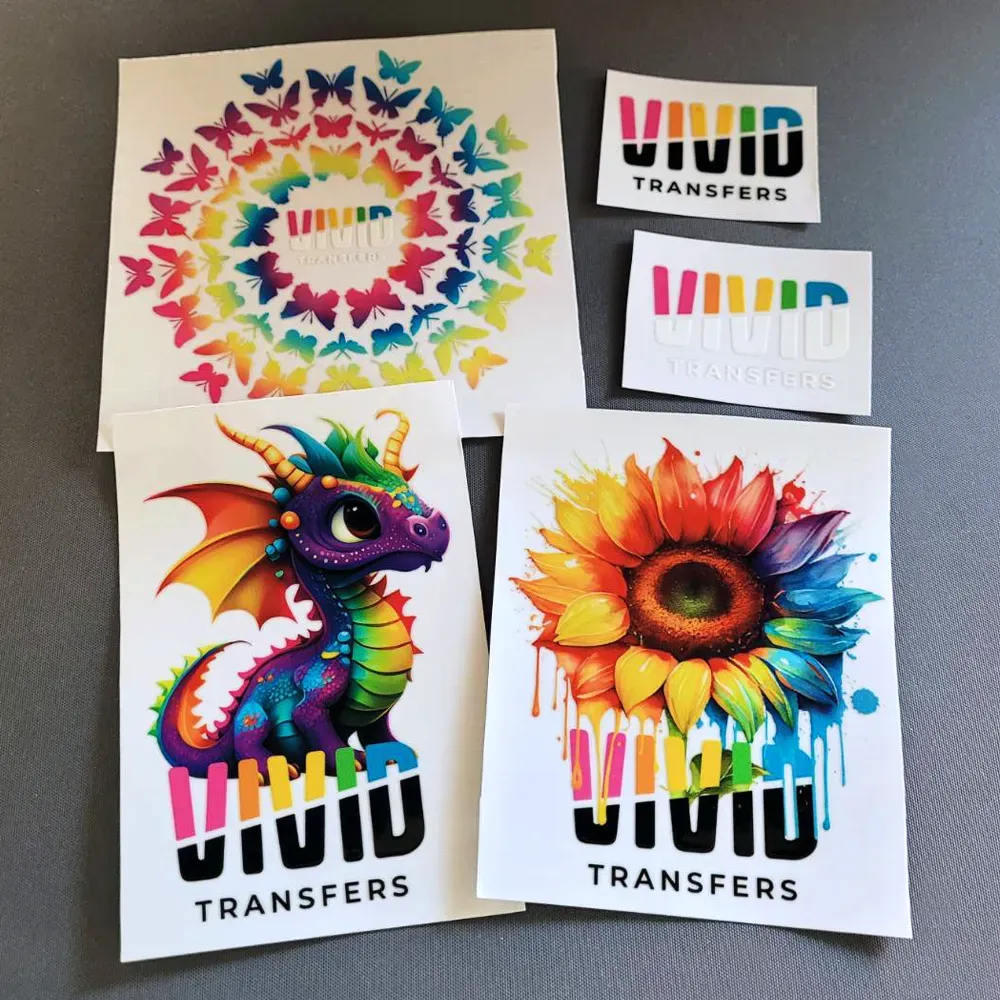UV DTF Transfers represent a cutting-edge solution in the realm of custom printing, merging advanced UV printing technology with the flexibility of direct-to-film printing methods. This innovative technique utilizes UV-cured inks to create stunning prints that are both vibrant and long-lasting, allowing users to transfer designs onto a wide array of materials, including textiles and hard surfaces. With its ability to produce high-quality results quickly, UV DTF printing is quickly gaining popularity among graphic designers and businesses alike, providing them with a reliable avenue for creating personalized merchandise. As we delve deeper into the nuances of UV DTF Transfers, you’ll discover how this technology enhances the efficiency of heat press applications and meets the demands of modern print projects. Join us as we explore the process and intricacies behind this revolutionary printing method, ensuring you’re equipped to harness its full potential.
Also known as UV direct-to-film printing, this technique allows for remarkable precision and versatility across various projects. With the ability to print on everything from textiles to rigid surfaces, UV DTF technology has become an essential tool for creatives looking to produce bespoke items. The process is signature for its rapid curing capabilities, ensuring that prints are not just vibrant but also durable enough for demanding applications. Recognized for its speed and quality, the UV DTF approach is reshaping the landscape of custom printing, making it significantly easier for small businesses and individuals to bring their creative visions to life. Dive into the world of this advanced printing method and learn how its innovative features can elevate your custom creations.
Understanding UV DTF Printing
UV Direct-to-Film (DTF) printing represents a significant advancement in custom printing technology. This method employs powerful UV-curable inks that are applied onto a special transfer film. Once printed, the inks are instantly cured under UV light, allowing for a quick turnaround and immediate handling. Unlike traditional printing methods that rely on lengthy drying times, UV DTF printing facilitates faster production cycles, making it highly beneficial for high-demand environments. As a result, businesses focusing on custom merchandise can streamline their operations while delivering superior quality products.
The applications of UV DTF printing are incredibly vast. This cutting-edge technique is not only suitable for textiles like t-shirts and bags but also excels in printing on hard surfaces such as glass, wood, and metal. The ability to create vibrant, durable prints that adhere well to a variety of materials sets UV DTF apart from other printing technologies. As a graphic designer or business owner, embracing UV DTF can significantly enhance your product range, opening doors to unique and creative opportunities.
Essential Equipment for UV DTF Transfers
Getting started with UV DTF printing requires specific equipment to ensure high-quality transfers. Firstly, you will need a UV flatbed printer or a dedicated UV DTF printer capable of producing detailed prints on the transfer film. Additionally, investing in a robust UV curing system is vital; these machines ensure that the inks dry quickly and adhere well to the transfer film, readying them for application to various surfaces.
Moreover, design software is essential for crafting and preparing your artwork for printing. Programs such as Adobe Illustrator or CorelDRAW provide tools that allow for precise control over your designs, helping you to achieve the best visual results. Lastly, a heat press is imperative, especially when applying transfers to textiles, ensuring a strong bond between the material and the printed design.
Design Preparation for Optimal Results
Preparing an effective design is crucial for successful UV DTF transfers. Start by utilizing graphic design software that allows you to create high-resolution designs tailored for print. It is essential to consider the color mode when designing; sticking to CMYK will help ensure your printed colors closely match what you see on your screen. This attention to detail can greatly influence the overall quality of your final product.
In addition to color settings, keep in mind the complexity of your design. Simpler designs may translate better onto films and surfaces, while intricate details may require higher resolution and careful consideration of how the inks will behave. By giving thought to every element of your design, you set a strong foundation from which to produce successful UV DTF transfers.
Understanding the Curing Process
Curing is a pivotal stage in the UV DTF printing process, as it solidifies the inks and prepares them for application. It is crucial to cure the printed film immediately after printing to ensure the longevity of the design. Passing the printed film under a UV lamp not only dries the inks but also enhances their adhesion properties, ensuring they bond effectively with whatever surface you plan to apply them to.
Proper curing can significantly affect the durability and appearance of your prints. If not adequately cured, the prints may be prone to smudging or peeling, particularly when applied to textiles. Understanding the curing requirements for both your inks and the intended surfaces will lead to far superior results in your UV DTF projects.
Application Techniques for Different Surfaces
When applying UV DTF transfers, the process differs depending on whether you are working with hard surfaces or textiles. For hard surfaces, the application can be straightforward; simply place the printed film onto the desired area and apply heat if needed. The real art lies in ensuring the print adheres well without bubbles or imperfections.
On the other hand, applying transfers to textiles requires specific temperature and timing considerations. Using a heat press set to the appropriate temperature ensures that the UV DTF transfer bonds excellently to the fabric, resulting in a lasting finish. It’s vital to follow the manufacturer’s guidelines regarding heat and pressure to achieve optimal adhesion and durability.
Maximizing Longevity of Your UV DTF Transfers
To maintain the integrity of your UV DTF transfers post-application, a few care strategies can significantly extend their lifespan. One fundamental practice is to allow the design to set for approximately 24 hours after application. This resting period enables the ink to fully adhere, enhancing durability against wear and tear.
Additionally, implementing proper washing instructions is essential, especially for textile applications. Different fabrics may require specific care, such as cold washes or air-drying, to prevent fading or damage to the printed design. By educating your customers about these care tips, you not only enhance the quality of your products but also foster trust and satisfaction.
Frequently Asked Questions
What are the key advantages of UV DTF Transfers in custom printing?
UV DTF Transfers offer numerous advantages, including durability, as they resist fading and scratching. They are highly versatile, enabling printing on both rigid surfaces like metal and flexible textiles. The instant curing process significantly speeds up production times, allowing for faster turnaround compared to traditional printing methods.
How does UV DTF printing technology work?
UV DTF printing technology uses UV-curable inks that are applied to a special transfer film. These inks are instantly cured under UV light, resulting in vibrant and durable prints that can easily adhere to various surfaces, making it ideal for custom printing.
What equipment is necessary for effective UV DTF Transfers?
To effectively produce UV DTF Transfers, you need a UV flatbed printer or dedicated UV DTF printer, UV transfer film, a curing system (UV light), design software like Adobe Illustrator or CorelDRAW, and a heat press for applying designs to textiles.
Can UV DTF Transfers be applied to both hard surfaces and textiles?
Yes, UV DTF Transfers are highly versatile and can be applied to a variety of materials including hard surfaces such as wood, metal, and glass, as well as textiles like t-shirts and bags when using a heat press.
What is the curing process in UV DTF printing, and why is it important?
Curing in UV DTF printing involves passing the printed transfer film under a UV light immediately after printing. This process solidifies the inks, ensuring they adhere well and are durable, which is crucial for long-lasting finishes.
What care should be taken after applying UV DTF Transfers to textiles?
After applying UV DTF Transfers to textiles, allow the design to set for about 24 hours to ensure maximum adhesion. Follow specific washing instructions based on the fabric type to maintain the integrity and longevity of the prints.
| Key Point | Details |
|---|---|
| What is UV DTF? | A printing technique using UV-curable inks on special film that is cured instantly for durability and quick production. |
| Applications | Suitable for hard surfaces like acrylic, glass, metal, wood and textiles, including shirts and bags. |
| Equipment Needed | UV flatbed or dedicated printer, transfer film, UV curing system, design software, heat press. |
| Design Preparation | Use graphic design software; design in CMYK for best color accuracy. |
| Printing Process | Load transfer film, adjust settings, and print while monitoring the process. |
| Curing | Cure the print immediately after printing to solidify inks and prepare for transfer. |
| Transfer Application | Position film on surface; apply heat for textiles according to guidelines. |
| Post-Application Care | Allow 24-hour setting time; follow specific wash care instructions for textiles. |
| Benefits | Durability, versatility across various surfaces, and quick production speed. |
| Latest Trends | Increasing adoption in businesses; improvements highlighted by industry publications. |
Summary
UV DTF Transfers are revolutionizing the custom printing landscape with their ability to deliver vibrant and durable prints across a wide range of materials. This technology harnesses UV-cured inks, which not only provide rapid curing but also exceptional adherence and longevity, making them ideal for both textiles and hard surfaces. As you embark on your journey with UV DTF transfers, understanding the key steps, from design preparation to application and care, will empower you to create stunning, high-quality prints. Keep abreast of evolving trends and advancements to maximize your printing capabilities and enhance your creative projects.


